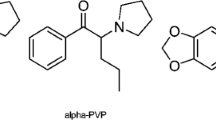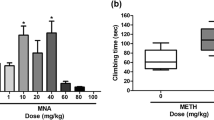Abstract
Rationale
Recent years have seen an increase in the recreational use of novel, synthetic psychoactive substances. There are little or no data on the abuse liability of many of the newer compounds.
Objectives
The current study investigated the discriminative stimulus and locomotor effects of a series of synthetic analogs of cathinone: α-pyrrolidinopropiophenone (α-PPP), α-pyrrolidinohexiophenone (α-PHP), α-pyrrolidinopentiothiophenone (α-PVT), 3,4-methylenedioxybutiophenone (MDPBP), and ethylone.
Methods
Locomotor activity was assessed in an open-field assay using Swiss-Webster mice. Discriminative stimulus effects were assessed in Sprague-Dawley rats trained to discriminate either cocaine or methamphetamine from vehicle.
Results
Each of the compounds produced an inverted-U dose-effect on locomotor activity. Maximal effects were similar among the test compounds, but potencies varied with relative potencies of MDPBP > α-PPP = α-PHP > ethylone > α-PVT. Each of the test compounds substituted fully for the discriminative stimulus effects of methamphetamine. α-PPP, α-PHP, and ethylone fully substituted for cocaine. α-PVT produced a maximum of 50% cocaine-appropriate responding, and MDPBP produced an inverted-U-shaped dose-effect curve with maximum effects of 67%.
Conclusions
These data provide initial evidence that these structurally similar, emerging novel psychoactive substances demonstrate potential for abuse and may be utilized for their stimulant-like effects, given their ability to stimulate locomotor activity and their substitution for the discriminative stimulus effects of the classical psychostimulants cocaine and/or methamphetamine.




Similar content being viewed by others
References
Baumann MH (2016) The changing face of recreational drug use. Cerebrum
Brandt SD, Freeman S, Sumnall HR, Measham F, Cole J (2011) Analysis of NRG ‘legal highs’ in the UK: identification and formation of novel cathinones. Drug Test Anal 3:569–575
Carter LP, Griffiths RR (2009) Principles of laboratory assessment of drug abuse liability and implications for clinical development. Drug Alcohol Depend 105S:S14–S25
Cheong JH, Choi MJ, Jang CG, Lee YS, Lee S, Kim HJ, Seo JW, Yoon SS. (2017) Behavioral evidence for the abuse potential of the novel synthetic cathinone alpha-pyrrolidinopentiothiophenone (PVT) in rodents. Psychopharmacology (Berl). Jan 9. [Epub ahead of print]
Eshleman AJ, Wolfrum KM, Reed JF, Kim SO, Swanson TS, Johnson RA, Janowsky A (2017) Structure-activity relationships of substituted cathinones, with transporter binding, uptake and release. J Pharmacol Exp Ther 360:33–47.
Gannon BM, Williamson A, Suzuki M, Rice KC, Fantegrossi WE (2016) Stereoselective effects of abused bath salt constituent 3,4-methylenedioxypyrovalerone (MDPV) in mice: drug discrimination, locomotor activity, and thermoregulation. J Pharmacol Ex Ther 356:615–623
Gatch MB, Dolan SB, Forster MJ (2015a) Comparative behavioral pharmacology of three pyrrolidine-containing synthetic cathinone derivatives. J Pharmacol Exp Ther 354:103–110
Gatch MB, Rutledge M, Forster MJ (2015b) Discriminative and locomotor effects of five synthetic cathinones in rats and mice. Psychopharmacology 232:1197–1205
Gatch MB, Taylor CM, Forster MJ (2013) Locomotor stimulant and discriminative stimulus effects of “bath salt” cathinones. Behav Pharmacol 24:437–447
Horton DB, Potter DM, Mead AN (2013) A translational pharmacology approach to understanding the predictive value of abuse potential assessments. Behav Pharmacol 24:10–36
Katz JL, Agoston GE, Alling KL, Kline RH, Forster MJ, Woolverton WL, Kopajtic TA, Newman AH (2001) Dopamine transporter binding without cocaine-like behavioral effects: synthesis and evaluation of benztropine analogs alone and in combination with cocaine in rodents. Psychopharmacology 154:362–374
Kikura-Hanajiri R, Kawamura NU, Goda Y (2014) Changes in the prevalence of new psychoactive substances before and after the introduction of the generic scheduling of synthetic cannabinoids in Japan. Drug Test Anal 6:832–839
Klavž J, Gorenjak M, Marinšek M (2016) Suicide attempt with a mix of synthetic cannabinoids and synthetic cathinones: case report of non-fatal intoxication with AB-CHMINACA, AB-FUBINACA, alpha-PHP, alpha-PVP and 4-CMC. Forensic Sci Int 265:121–124
Knoy JL, Peterson BL, Couper FJ (2014) Suspected impaired driving case involving α-pyrrolidinovalerophenone, methylone and ethylone. J Anal Toxicol 38:615–617
Marusich JA, Antonazzo KR, Wiley JL, Blough BE, Partilla JS, Baumann MH (2014) Pharmacology of novel synthetic stimulants structurally related to the “bath salts” constituent 3,4-methylenedioxypyrovalerone (MDPV). Neuropharmacology 87:206–213
McIntyre IM, Hamm CE, Sherrard JL, Gary RD, Burton CG, Mena O (2015) Acute 3,4-methylenedioxy-N-ethylcathinone (ethylone) intoxication and related fatality: a case report with postmortem concentrations. J Anal Toxicol 39:225–228
National Research Council (2011) Guide for the care and use of laboratory animals. TheNational Academies Press, Washington
Naylor JE, Freeman KB, Blough BE, Woolverton WL, Huskinson SL (2015) Discriminative-stimulus effects of second generation synthetic cathinones in methamphetamine-trained rats. Drug Alcohol Depend 149:280–284
Odoardi S, Romolo FS, Strano-Rossi S (2016) A snapshot on NPS in Italy: distribution of drugs in seized materials analysed in an Italian forensic laboratory in the period 2013-2015. Forensic Sci Int 265:116–120
Reitzel LA, Dalsgaard PW, Müller IB, Cornett C (2012) Identification of ten new designer drugs by GC-MS, UPLC-QTOF-MS, and NMR as part of a police investigation of a Danish internet company. Drug Test Anal 4:342–354
Schneir A, Ly BT, Casagrande K, Darracq M, Offerman SR, Thornton S, Smollin C, Vohra R, Rangun C, Tomaszewski C, Gerona RR (2014) Comprehensive analysis of “bath salts” purchased from California stores and the internet. Clin Toxicol (Phila) 52:651–658
Sellors K, Jones A, Chan B (2014) Death due to intravenous use of α-pyrrolidinopentiophenone. Med J Aust 201:601–603
Simmler LD, Buser TA, Donzelli M, Schramm Y, Dieu LH, Huwyler J, Chaboz S, Hoener MC, Liechti ME (2013) Pharmacological characterization of designer cathinones in vitro. Br J Pharmacol 168(2):458–470
Smith DA, Blough BE, Banks ML (2017) Cocaine-like discriminative stimulus effects of amphetamine, cathinone, methamphetamine, and their 3,4-methylenedioxy analogs in male rhesus monkeys. Psychopharmacology 234:117–127
Smith DA, Negus SS, Poklis JL, Blough BE, Banks ML (2016) Cocaine-like discriminative stimulus effects of alpha-pyrrolidinovalerophenone, methcathinone and their 3,4-methylenedioxy or 4-methyl analogs in rhesus monkeys. Addict Biol Apr 6 [Epub ahead of print]
Varner K, Daigle K, Weed P, Lewis P, Mahne S, Sankaranarayanan A, Winsauer P (2013) Comparison of the behavioral and cardiovascular effects of mephedrone with other drugs of abuse in rats. Psychopharmacology 225:675–685
Wojcieszak J, Andrzejczak D, Woldan-Tambor A, Zawilska JB (2016) Cytotoxic activity of pyrovalerone derivatives, an emerging group of psychostimulant designer cathinones. Neurotox Res 30:239–250
Author information
Authors and Affiliations
Corresponding author
Ethics declarations
All housing and procedures were in accordance with Guidelines for the Care and Use of Laboratory Animals (National Research Council 2011) and were approved by the University of North Texas Health Science Center Animal Care and Use Committee.
Rights and permissions
About this article
Cite this article
Gatch, M.B., Dolan, S.B. & Forster, M.J. Locomotor activity and discriminative stimulus effects of a novel series of synthetic cathinone analogs in mice and rats. Psychopharmacology 234, 1237–1245 (2017). https://doi.org/10.1007/s00213-017-4562-4
Received:
Accepted:
Published:
Issue Date:
DOI: https://doi.org/10.1007/s00213-017-4562-4




